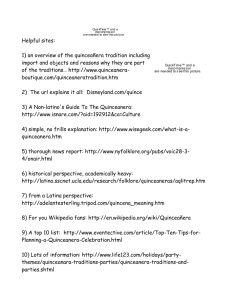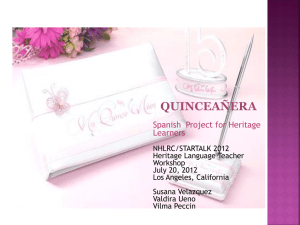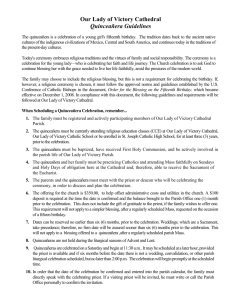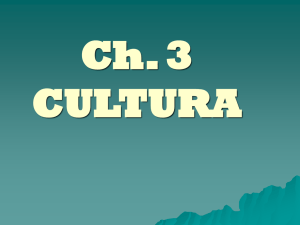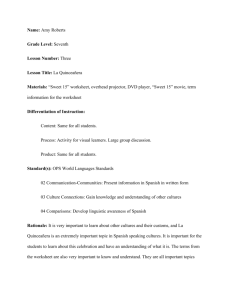Nora Medrano EDFR 6388.01 Dr. O'Connor 20 September 2013
advertisement
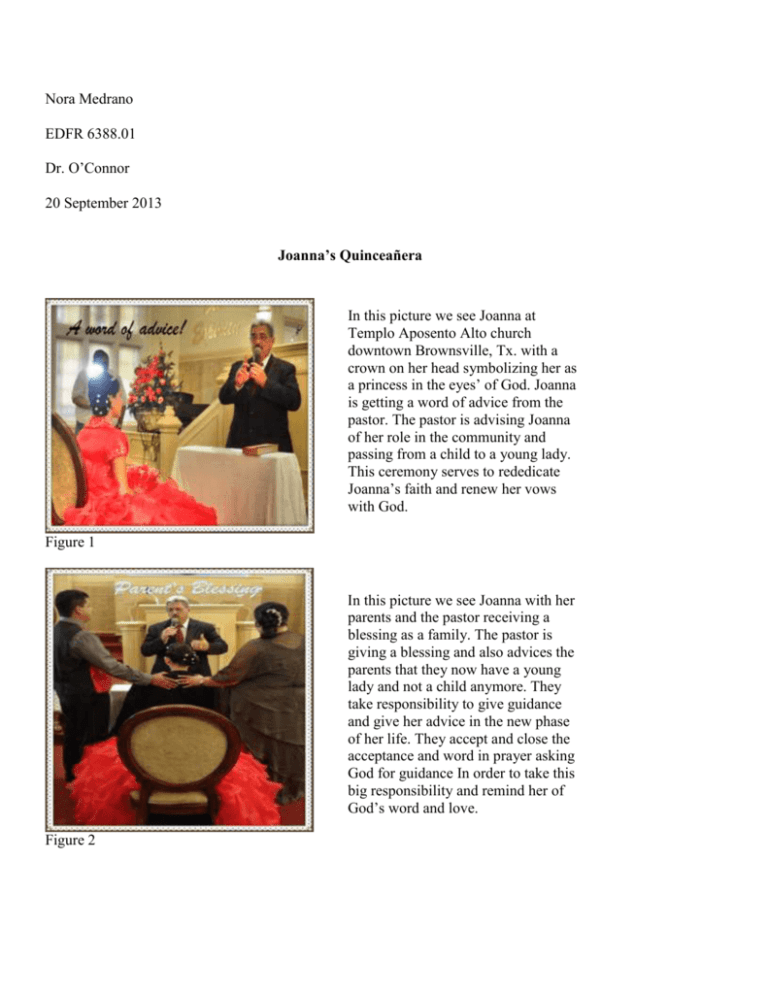
Nora Medrano EDFR 6388.01 Dr. O’Connor 20 September 2013 Joanna’s Quinceañera In this picture we see Joanna at Templo Aposento Alto church downtown Brownsville, Tx. with a crown on her head symbolizing her as a princess in the eyes’ of God. Joanna is getting a word of advice from the pastor. The pastor is advising Joanna of her role in the community and passing from a child to a young lady. This ceremony serves to rededicate Joanna’s faith and renew her vows with God. Figure 1 In this picture we see Joanna with her parents and the pastor receiving a blessing as a family. The pastor is giving a blessing and also advices the parents that they now have a young lady and not a child anymore. They take responsibility to give guidance and give her advice in the new phase of her life. They accept and close the acceptance and word in prayer asking God for guidance In order to take this big responsibility and remind her of God’s word and love. Figure 2 Every quinceañera has padrinos, which serve as guidance for Joanna. The padrinos play a big role for many young ladies because they could count on them for advise and could even be there for the young lady incase her parents’ cease. The padrinos give the quinceañera a gift as a resemblance of faith. In this case these padrinos gave Joanna a pair of earrings. The resemblance of the earrings is to remind Joanna to keep her ears tuned to God. Since they were given at the church ceremony, the pastor prays over them to bless them. This is a great deal for the quinceañera they are very special to her. Figure 3 Time has come for the party after the church service. There is a lot of planning done for this part of the process for the quinceañera. The parents together with the padrinos get food ready, centerpieces, decorations for the hall, and of course the dress. At this point in time when they are arriving to the ballroom, the parents, the mother on one side and the father on the other side walk Joanna through the dace floor and around all the tables introducing their daughter to all the party attendees. This part of the quinceañera is very importance because the parents are showing their daughter to society and to the rest of the world not as a child but as a young lady. Figure 4 Figure 5 Towards the end of the party, which typically ends about 12 AM for quinceañeras, the parents together with their immediate family take time to take some pictures for memories. Here we see the mother, father, two younger siblings, and the quinceañeras boyfriend. The family takes pictures together to build memories and usually put an album together for the quinceañera for her to look over, as she gets older. Everyone here is happy and having a good time, enjoying family, friends, good food, and great music. What you all don’t know is that the quinceañera has not opened her surprise gift yet- this is a gift given by a padrino to give to Joana. She is anxiously awaiting for picture time to finish to go open her gift. Want to know what it was? It was “la ultima muneca”. This is very valuable to her because this symbolizes her trading her toys for grown up responsibilities. The quinceañera is a celebration where a young girl celebrates her 15th birthday of life. This custom dates back to 600 years ago when the Mayan and Aztecs celebrated young girls into young woman hood and eligible to marry and take responsibilities upon her community. Catholicism was the main religion involved with quinceañera celebrations but throughout time the Spaniards began celebrating and other religions like Christians began to celebrate as well. Many different countries celebrate a quinceañera but it is named and celebrated differently according to their beliefs, religion, and customs. For example in Argentina a quinceañera is referred to a “fiesta de quince”, in Brazil it is considered a “fiesta de debutantes”, and in Ecuador it is simply considered as a “quince”. Since Joanna is Mexican American we will look more into depth about custom and traditions in Mexican quinceañeras. In Mexico the quinceañera wears elegant makeup, a beautiful formal ballroom dress- this is usually pink but in many occasions the quinceañera chooses another color, personal hair-do, and wears a crown on her head which symbolizes that she is a “princess” in God’s eyes. If the quinceañera is Catholic she begins with a mass service, if the quinceañera is Christian, she also begins with a church service involving different steps. At the church service the father or pastor gives “words of advice” just like seen on Figure 1. Here the quinceañera receives advice and blessings from the pastor in which he tells her that she is no longer a child but a young woman and explains that she is now ready to take responsibilities and be part of the community. This continues with the “parent’s blessings” as seen on Figure 2. At this time the parents give a blessing to the quinceañera and usually pray for her and accept the responsibility upon them to guide her spiritually and guide her throughout her life. The padrinos or Godparents give the quinceañera a gift as a resemblance of transitioning from a girl to a young woman as seen in Figure 3. After church service, she is then taken to the party location where she arrives with her parents, godparents, and court. The court usually consists of a chosen group of friends who are paired-off girl and boy. This group of young men and woman are the quinceañeras friends and usually prepare a dance together with the quinceañera to entertain the attendees. The celebration at the dance hall or reception consists of six steps in which is not usually followed because of different religions and celebration preferences. This consists of first, the quinceañeras formal entrance once everyone is in the ballroom as seen in Figure 4, a toast (optional), a first dance made by the quinceañera herself and her father. If the quinceañera does not have a father it would be her grandfather, uncle, or a man who is very close to her, which she looks up to and is a father figure to her. Then we have the family dance which is usually only for the close family members then there is a favorite song which is usually a show the quinceañera puts together with her court to entertain her family and friends. Finally, we have the general dance for all her friends and family to enjoy and have a great time celebrating. Once these gestures and entertainment has been completed a seated dinner or appetizers are proceeded. Music bands or DJ begins to play while people are having dinner and talk to one another and or dance. Throughout the day the family of the quinceañera or a padrino pays for pictures to be taken throughout to have memories of her special day. The pictures are taken at the church service and at the reception hall event. The quinceañera takes some time from having so much fun with friends to take pictures with family as seen in Figure 5. This is a day the quinceañera will never forget this special occasion full of laughter, happiness, family, and friends. According to (Ochs & Shohet, 2006) “Cultural sites are given life through recurrent social participation and longevity through efforts to socialize novices into the predilections, sentiments, and actions that undergird meaningful participation”. One day Joanna will have the privilege and opportunity to share this special with her future daughter, although she might not do things exactly as her mother did she will still share a Mexican tradition and remember her childhood all over again. Through this “learning experience” according to (Dewey) she is making that forward and backwards connection, which is the reason there is an experience, and we do them because they provide this joy or consequence in our life. References (2001). Democracy and education by john dewey a penn state electronic classics series publication. Retrieved from https://myutb.blackboard.com/bbcswebdav/pid-3969113-dt-content-rid13519076_2/courses/2013FA_EDFR_6388_01/Dewey - Democracy & Education.pdf Ochs, E., & Shohet, M. (2006). The cultural structuring of mealtime socialization. 35-49. Retrieved from https://myutb.blackboard.com/bbcswebdav/pid-3969125-dt-content-rid13519087_2/courses/2013FA_EDFR_6388_01/Ochs & Shohet 2006 - Cultural structuring of mealtime socialization.pdf The meaning of a quinceanera. (n.d.). Retrieved from http://www.bilingualminister.com/uploads/3/0/8/3/3083307/the_meaning_of_a_quinceanera_1.pdf Quinceañera. (n.d.). Retrieved from http://en.wikipedia.org/wiki/Quinceañera
